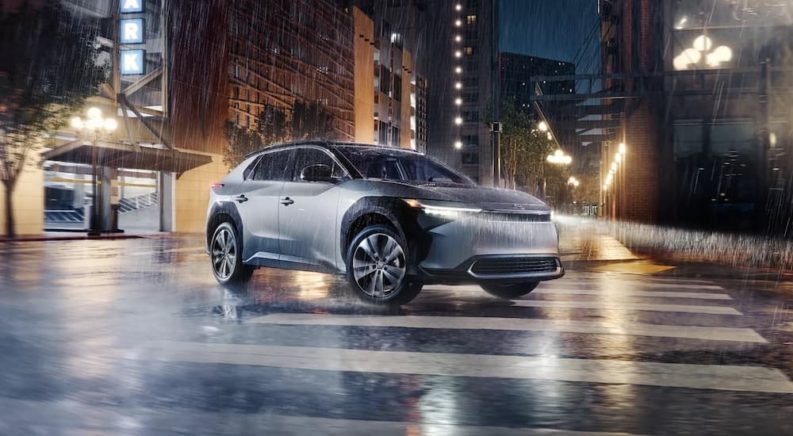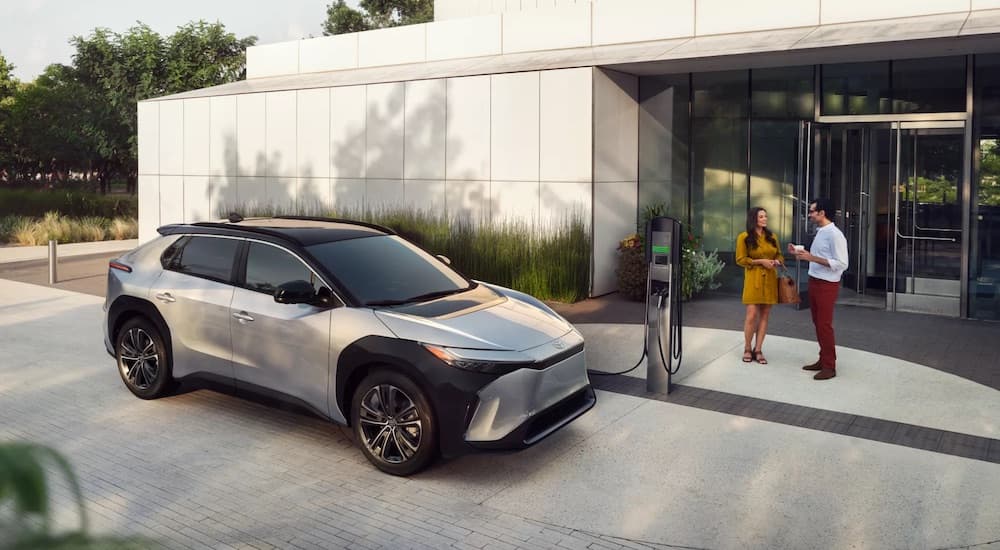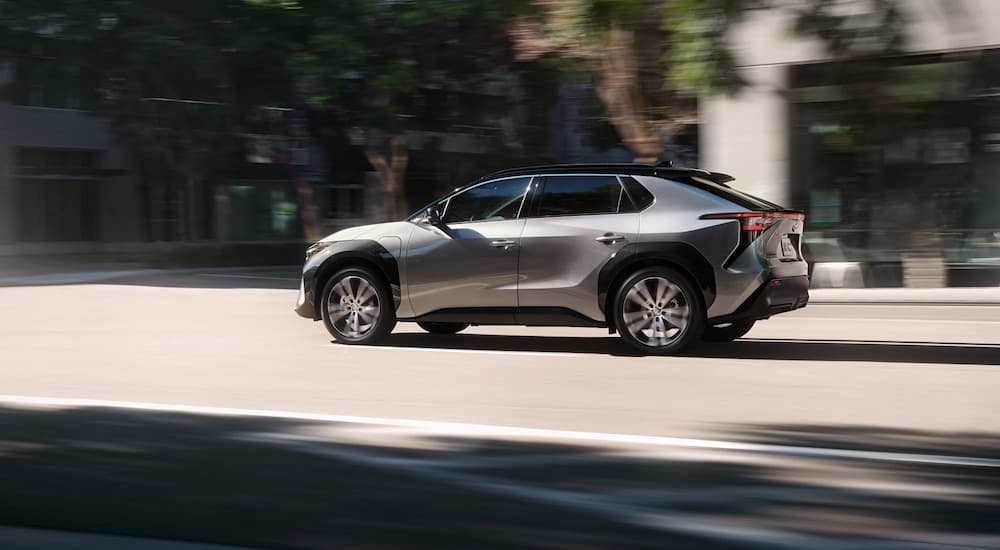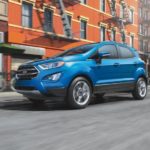It’s a little hard to believe that the company responsible for the Prius—and with it, almost the entire market of hybrid electric vehicles—is this late to the battery electric vehicle (BEV) game, but it’s true. The year is 2022 and the world is finally seeing the first mass-market Toyota BEV—the 2023 Toyota bZ4X. (Please don’t make me type it again.)
We’ve really gotten used to it by now, haven’t we? After Tesla exposed us to the realities of all-electric performance, it seems that every EV to follow wants to blow everyone’s minds with brain-melting acceleration and handling that just shouldn’t be reasonable for 3-ton vehicles. It made sense for the Model Y, as surprising acceleration plus range is kind of Tesla’s thing. It also made sense for the Mach E—that thing’s a Mustang!
But did the Hyundai/Kia compact crossover EVs need to have sub-5-second 0-60 times? I’ll submit that they did not. Does every compact crossover EV need to include a RWD configuration in the base models—long the domain of trucks and sports cars? I also submit that they do not. Is any prospective EV buyer even slightly fooled that, despite relatively low base MSRPs, the most desirable configurations of any of these models no longer qualify as “affordable”?
Well, maybe. I’m not sure how many drivers are out there for whom $42k is tolerable but $50k is not. But my point is, the new Toyota EV doesn’t need to be upgraded to maximize its value. The flip side is: How much value is that, really?
The Problem with Electric Vehicles
Toyota has always believed that the world isn’t ready to switch to EVs. They developed hybrid technology early, have arguably mastered the genre (and inarguably dominated it), and leaned in hard while everybody else made massive BEV commitments. Akio Toyoda himself has long been critical of legislation that exclusively supports BEV adoption to the detriment of alternative emissions-reducing technology; the company is still committed to achieving carbon neutrality, but not by eliminating vehicle emissions. They believe in a sustainable, reliable supply chain and manufacturing process that offset the minimal emissions created by the operation of hybrid vehicles. Full BEVs, meanwhile, hungry for lithium and charging time, don’t align well with Toyota’s philosophy.
So it isn’t surprising that it’s taken them so long, and perhaps it’s also fitting that this is hardly the mold-breaker we’re accustomed to seeing for releases in this segment. Honestly, regarding Toyota’s perspective on BEVs, the first model of the “Beyond Zero” series of Toyotas is in several ways a self-fulfilling prophecy. While Toyota is investing in significantly expanded operations in North America and around the world supporting hybrid and plug-in hybrid vehicle production—and their ongoing market dominance is enabled by a relatively strong supply chain for semiconductors and micro-chips—they were unable to secure a single source of EV batteries with enough supply to build the entire forecasted run of their electric crossover. As a result, one supplier is responsible for batteries for FWD models, and another makes batteries for the AWD version.
This has a horrifying downside. Yes, the AWD version with two motors is more powerful, but only just (instead of simply adding a second motor to create AWD, as other brands do, the 150 kW FWD motor is replaced by two 80 kW motors to make it AWD). And yes, it’s normal to sacrifice a few dozen miles of range for AWD configurations too, because of the lower efficiency of AWD operation.
No, a 30-minute 10%-to-80% recharge time isn’t terrible, although the 176 miles of range provided in that time is low for the segment. However, that’s for the FWD battery. The AWD battery comes with architectural restrictions that limit the charge speed to half that, requiring an hour to replenish that same charge.
Let me break that down a bit. If you’re on a cross-country road trip, 176 miles is about 2.5 hours worth of driving. At that point, you will need to stop for more than an hour to recharge that energy—increasing your travel time by 45%! Okay, so a cross-country road tripper the Toyota BEV is not. But it’s still a capable off-roader and reliable commuter for snowy winters, right? Weeeeellll….
That finally brings me to the horrifying downside. Many people know, or would not be surprised to learn, that EV performance may suffer in cold climates. Batteries don’t like being cold; as a rule, they charge slower, hold less charge, and degrade more quickly. But Toyota says this AWD battery suffers severely degraded charging speeds at a temperature of 50° F. I’m writing this in May, and it’s going to get that cold here 4 times in the next week! That means for more than half the year I could expect WORSE than 1 hour for 80% fast charging. But that’s not all; at temperatures of 32° F or colder, this battery might not fast charge at all!]
So here’s Toyota, finally getting into the BEV game with a model that I shall not name again aloud or in text (except as the Toyota Busy-Forks), presenting an AWD configuration that barely does a thing for commuters who desire AWD. I guess it’s really an off-roading thing; the truth is, if you’re only looking for AWD to handle snowy commutes, the base FWD configuration will serve just fine and offer a better range/charging experience for your trouble. The big benefit of Toyota sticking with FWD instead of using an inexplicable and unnecessary RWD design is that it’s surprisingly adept in the snow!
Beyond this shockingly limp AWD configuration, the Toyota Busy-Forks is actually compelling for non-enthusiast drivers who are looking to this for classic Toyota value and reliability vs. the competition. The Korean models are too expensive, Tesla/Ford too glitchy, VW too button-less. Its base configuration is well-appointed; it features Toyota’s latest infotainment system; Toyota Safety Sense 3.0 is excellent; and it slots somewhere between the RAV4, Venza, and Highlander in size—in other words, it’s almost exactly what we should have expected from a Toyota BEV.
It’s All in the Name
In the automotive industry, one can often distinguish between mainstream market-brand models and premium upmarket brands by naming alone. Toyota makes the Avalon, RAV4, Highlander, and Land Cruiser; Lexus makes the ES, NX, RX, and LX. Some letters and numbers are subtle nods to the size and/or class of the vehicle; others indicate which powertrain you’ll find onboard. The bZ4X—I copy-pasted it, doesn’t count as typing—is an attempt at this kind of coding that could only have been designed by people who rarely use the English language or QWERTY keyboards.
Let’s break it down: “bZ”, the short form of “Beyond Zero,” signifies a series of vehicles that will make up 7 of Toyota’s 15 upcoming BEVs during their transformation to a lineup that includes 70 electrified models. The Beyond Zero principle emphasizes going further than the expected: a BEV with a re-imagined interior space, cutting-edge technology, high efficiency, and a wholly sustainable product lifecycle.
Anyway, the “4” refers to its size—so a “2” might be a sub-compact and a “6” a mid-size—and the “X” refers to the AWD option—a Subaru symmetrical AWD with X-MODE, no less. So, the name is a code, and that’s great, but it definitely doesn’t roll off the tongue. “Busy-Forks” it is!
So Why Bother?
I understand if you’re cynical about this car. The Busy-Forks has paired its AWD configuration with a terrible cold-weather battery, it offers no give-yourself-a-concussion acceleration options, and it simply doesn’t have the range of most competitors. Even Toyota’s aspirations are limited, with expected sales of only 7000 units. But there’s one good reason to believe in this Car-Which-Must-Not-Be-Named: It’s a Toyota compact crossover.
Despite what automotive YouTube would have you believe, most people are not driving enthusiasts. For a lot of people, their pedals have never met metal; their favorite way to drift is off to sleep; and odds are even that when you ask if they track their car, they’ll say, “Why would I? I’m the only one that drives it—I know where it is.”
And that’s okay! The vast majority of us don’t need and/or can’t afford for our cars to be any more than appliances—tools to bring us, our people, and our stuff to work. And hopefully, that process is as easy, efficient, and comfortable as possible.
The 2023 Toyota bZ4X (copy-pasted again) might be the most sensible EV on the market for that crowd. Unlike most competitors, which require significant upgrades to deliver their best value, the Toyota might be at its best in base form—with few options unavailable to the XLE trim and a capable, reliable powertrain in the FWD layout. While it’s Toyota’s first BEV, their reputation for quality and everyday value is the best in the business. They’ve been the best at delivering hybrid technology for years. Maybe, just maybe, if we give it a chance, the car that everyone is going to reference as “the electric Toyota” opens the door to actual “electric for all” manufacturing.






